MOD003507: Tesco's International Marketing Strategy and Expansion Plan
VerifiedAdded on 2022/12/23
|17
|4322
|54
Report
AI Summary
This report provides a comprehensive analysis of Tesco's international marketing strategy, focusing on its expansion into Australia. It begins with a company background, market share, and international position. Task 1 introduces the international marketing mix and defines international marketing, identifying Australia as the target expansion country. The report then applies the SOSTAC framework, conducting situational analysis using SWOT and PESTEL. Objectives, including mission statements and organizational aims, are discussed, alongside branding strategies. Porter's Generic Strategy is applied, with a focus on cost leadership. Tactics involving product life cycles, product portfolios, Boston Matrix, pricing strategies, and distribution methods are examined. Task 2 applies SOSTAC in the UK, evaluating product, price, and place. Task 3 analyzes PESTEL findings and explores standardization/adaptation approaches. The report concludes with a discussion of Tesco's strategic approach to international expansion.

1
International Marketing
International Marketing
Paraphrase This Document
Need a fresh take? Get an instant paraphrase of this document with our AI Paraphraser
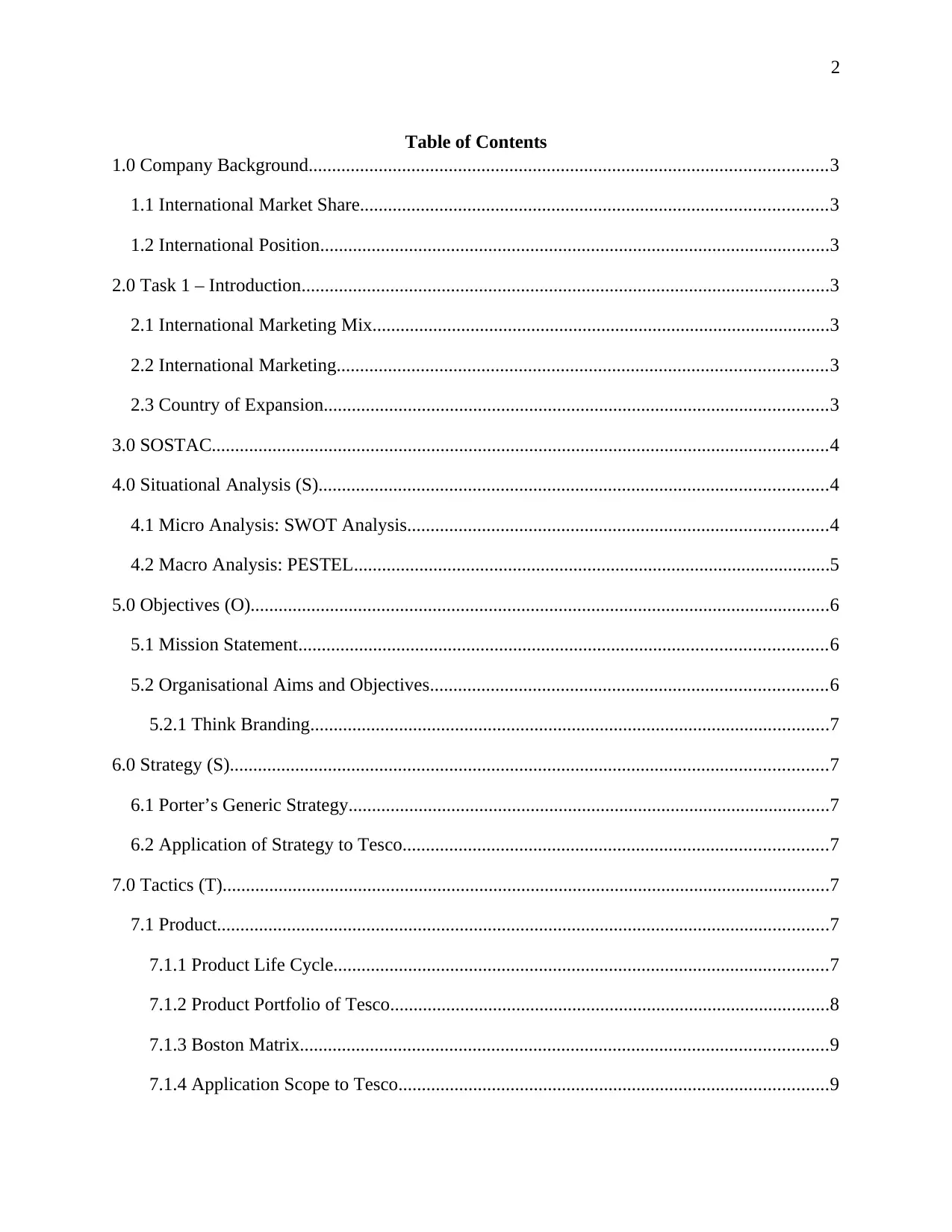
2
Table of Contents
1.0 Company Background...............................................................................................................3
1.1 International Market Share....................................................................................................3
1.2 International Position.............................................................................................................3
2.0 Task 1 – Introduction.................................................................................................................3
2.1 International Marketing Mix..................................................................................................3
2.2 International Marketing.........................................................................................................3
2.3 Country of Expansion............................................................................................................3
3.0 SOSTAC....................................................................................................................................4
4.0 Situational Analysis (S).............................................................................................................4
4.1 Micro Analysis: SWOT Analysis..........................................................................................4
4.2 Macro Analysis: PESTEL......................................................................................................5
5.0 Objectives (O)............................................................................................................................6
5.1 Mission Statement.................................................................................................................6
5.2 Organisational Aims and Objectives.....................................................................................6
5.2.1 Think Branding...............................................................................................................7
6.0 Strategy (S)................................................................................................................................7
6.1 Porter’s Generic Strategy.......................................................................................................7
6.2 Application of Strategy to Tesco...........................................................................................7
7.0 Tactics (T)..................................................................................................................................7
7.1 Product...................................................................................................................................7
7.1.1 Product Life Cycle..........................................................................................................7
7.1.2 Product Portfolio of Tesco..............................................................................................8
7.1.3 Boston Matrix.................................................................................................................9
7.1.4 Application Scope to Tesco............................................................................................9
Table of Contents
1.0 Company Background...............................................................................................................3
1.1 International Market Share....................................................................................................3
1.2 International Position.............................................................................................................3
2.0 Task 1 – Introduction.................................................................................................................3
2.1 International Marketing Mix..................................................................................................3
2.2 International Marketing.........................................................................................................3
2.3 Country of Expansion............................................................................................................3
3.0 SOSTAC....................................................................................................................................4
4.0 Situational Analysis (S).............................................................................................................4
4.1 Micro Analysis: SWOT Analysis..........................................................................................4
4.2 Macro Analysis: PESTEL......................................................................................................5
5.0 Objectives (O)............................................................................................................................6
5.1 Mission Statement.................................................................................................................6
5.2 Organisational Aims and Objectives.....................................................................................6
5.2.1 Think Branding...............................................................................................................7
6.0 Strategy (S)................................................................................................................................7
6.1 Porter’s Generic Strategy.......................................................................................................7
6.2 Application of Strategy to Tesco...........................................................................................7
7.0 Tactics (T)..................................................................................................................................7
7.1 Product...................................................................................................................................7
7.1.1 Product Life Cycle..........................................................................................................7
7.1.2 Product Portfolio of Tesco..............................................................................................8
7.1.3 Boston Matrix.................................................................................................................9
7.1.4 Application Scope to Tesco............................................................................................9
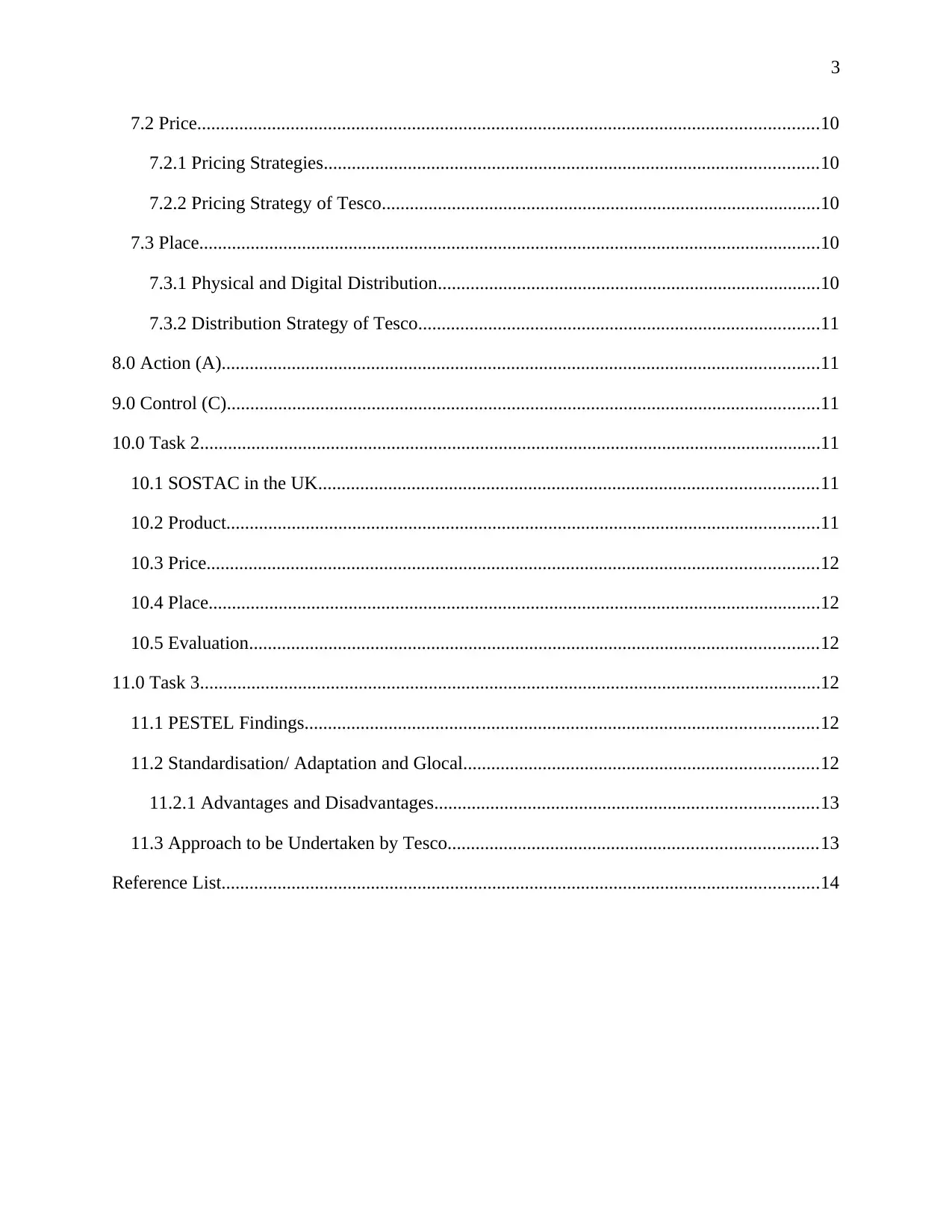
3
7.2 Price.....................................................................................................................................10
7.2.1 Pricing Strategies..........................................................................................................10
7.2.2 Pricing Strategy of Tesco..............................................................................................10
7.3 Place.....................................................................................................................................10
7.3.1 Physical and Digital Distribution..................................................................................10
7.3.2 Distribution Strategy of Tesco......................................................................................11
8.0 Action (A)................................................................................................................................11
9.0 Control (C)...............................................................................................................................11
10.0 Task 2.....................................................................................................................................11
10.1 SOSTAC in the UK...........................................................................................................11
10.2 Product...............................................................................................................................11
10.3 Price...................................................................................................................................12
10.4 Place...................................................................................................................................12
10.5 Evaluation..........................................................................................................................12
11.0 Task 3.....................................................................................................................................12
11.1 PESTEL Findings..............................................................................................................12
11.2 Standardisation/ Adaptation and Glocal............................................................................12
11.2.1 Advantages and Disadvantages..................................................................................13
11.3 Approach to be Undertaken by Tesco...............................................................................13
Reference List................................................................................................................................14
7.2 Price.....................................................................................................................................10
7.2.1 Pricing Strategies..........................................................................................................10
7.2.2 Pricing Strategy of Tesco..............................................................................................10
7.3 Place.....................................................................................................................................10
7.3.1 Physical and Digital Distribution..................................................................................10
7.3.2 Distribution Strategy of Tesco......................................................................................11
8.0 Action (A)................................................................................................................................11
9.0 Control (C)...............................................................................................................................11
10.0 Task 2.....................................................................................................................................11
10.1 SOSTAC in the UK...........................................................................................................11
10.2 Product...............................................................................................................................11
10.3 Price...................................................................................................................................12
10.4 Place...................................................................................................................................12
10.5 Evaluation..........................................................................................................................12
11.0 Task 3.....................................................................................................................................12
11.1 PESTEL Findings..............................................................................................................12
11.2 Standardisation/ Adaptation and Glocal............................................................................12
11.2.1 Advantages and Disadvantages..................................................................................13
11.3 Approach to be Undertaken by Tesco...............................................................................13
Reference List................................................................................................................................14
⊘ This is a preview!⊘
Do you want full access?
Subscribe today to unlock all pages.

Trusted by 1+ million students worldwide
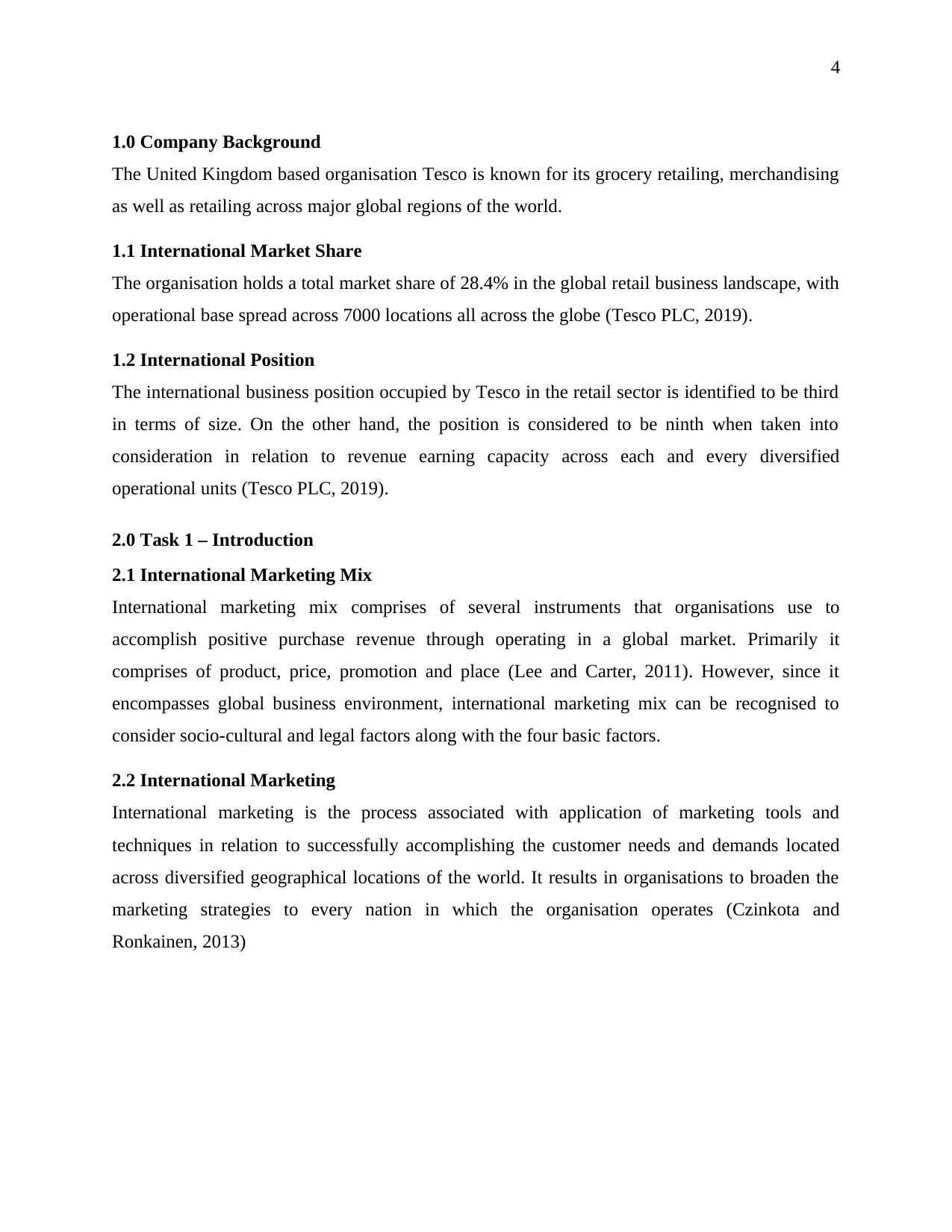
4
1.0 Company Background
The United Kingdom based organisation Tesco is known for its grocery retailing, merchandising
as well as retailing across major global regions of the world.
1.1 International Market Share
The organisation holds a total market share of 28.4% in the global retail business landscape, with
operational base spread across 7000 locations all across the globe (Tesco PLC, 2019).
1.2 International Position
The international business position occupied by Tesco in the retail sector is identified to be third
in terms of size. On the other hand, the position is considered to be ninth when taken into
consideration in relation to revenue earning capacity across each and every diversified
operational units (Tesco PLC, 2019).
2.0 Task 1 – Introduction
2.1 International Marketing Mix
International marketing mix comprises of several instruments that organisations use to
accomplish positive purchase revenue through operating in a global market. Primarily it
comprises of product, price, promotion and place (Lee and Carter, 2011). However, since it
encompasses global business environment, international marketing mix can be recognised to
consider socio-cultural and legal factors along with the four basic factors.
2.2 International Marketing
International marketing is the process associated with application of marketing tools and
techniques in relation to successfully accomplishing the customer needs and demands located
across diversified geographical locations of the world. It results in organisations to broaden the
marketing strategies to every nation in which the organisation operates (Czinkota and
Ronkainen, 2013)
1.0 Company Background
The United Kingdom based organisation Tesco is known for its grocery retailing, merchandising
as well as retailing across major global regions of the world.
1.1 International Market Share
The organisation holds a total market share of 28.4% in the global retail business landscape, with
operational base spread across 7000 locations all across the globe (Tesco PLC, 2019).
1.2 International Position
The international business position occupied by Tesco in the retail sector is identified to be third
in terms of size. On the other hand, the position is considered to be ninth when taken into
consideration in relation to revenue earning capacity across each and every diversified
operational units (Tesco PLC, 2019).
2.0 Task 1 – Introduction
2.1 International Marketing Mix
International marketing mix comprises of several instruments that organisations use to
accomplish positive purchase revenue through operating in a global market. Primarily it
comprises of product, price, promotion and place (Lee and Carter, 2011). However, since it
encompasses global business environment, international marketing mix can be recognised to
consider socio-cultural and legal factors along with the four basic factors.
2.2 International Marketing
International marketing is the process associated with application of marketing tools and
techniques in relation to successfully accomplishing the customer needs and demands located
across diversified geographical locations of the world. It results in organisations to broaden the
marketing strategies to every nation in which the organisation operates (Czinkota and
Ronkainen, 2013)
Paraphrase This Document
Need a fresh take? Get an instant paraphrase of this document with our AI Paraphraser

5
2.3 Country of Expansion
Tesco is largely looking forward to expanding its business operational activities to Australia.
Although the organisation has successfully expanded to a large number of countries in the world,
however, Australia, one of the prospective locations is yet to be explored by the supermarket
retailer.
3.0 SOSTAC
SOSTAC is one of the notable marketing tools that goes ahead with providing
organisations with the capability of operating in a wide range of commercial solutions. There are
six fundamental aspects highlighted in SOSTAC, situation, objectives, strategy, tactics, action
and control (FIDM, 2014). Based on the information gained using this model, an organisation
can go ahead with developing marketing campaigns during new product launch as well as
expansion to a new country.
4.0 Situational Analysis (S)
Situation analysis provides organisational managers with a set of tools that can be used for the
purpose of analysing its internal and external business operational environment (Westwood,
2013). The information thereby gained is critical to helping the organisation in gaining adequate
2.3 Country of Expansion
Tesco is largely looking forward to expanding its business operational activities to Australia.
Although the organisation has successfully expanded to a large number of countries in the world,
however, Australia, one of the prospective locations is yet to be explored by the supermarket
retailer.
3.0 SOSTAC
SOSTAC is one of the notable marketing tools that goes ahead with providing
organisations with the capability of operating in a wide range of commercial solutions. There are
six fundamental aspects highlighted in SOSTAC, situation, objectives, strategy, tactics, action
and control (FIDM, 2014). Based on the information gained using this model, an organisation
can go ahead with developing marketing campaigns during new product launch as well as
expansion to a new country.
4.0 Situational Analysis (S)
Situation analysis provides organisational managers with a set of tools that can be used for the
purpose of analysing its internal and external business operational environment (Westwood,
2013). The information thereby gained is critical to helping the organisation in gaining adequate

6
insights into its individual competencies, customers and the likely chances of success as well as
further business prospects available in the present operational environment.
4.1 Micro Analysis: SWOT Analysis
Strengths Weaknesses
Operational reach of Tesco is vast and
diversified to a large number of
locations across the globe.
Product portfolio is very strong, well
suited to the needs and demands of
customers from every section of the
society.
Competition in retail sector has
resulted in Tesco to get engage in
price war with competitor
organisations.
Poor operational effectiveness across
different format developed by Tesco
has failed significant
Opportunities Threats
Tesco can go ahead with strategic
acquisitions in relation to increasing
operational effectiveness further.
Rapid market expansion scope
available in developing nations of the
world.
BREXIT is found to severely impact
the operational activities of
supermarket.
Competition with other supermarkets
is likely to increases significantly.
4.2 Macro Analysis: PESTEL
Political: The operational activity of Tesco is required to comply with trade rules and regulations
imposed by Government of Australia. The country encompasses some of the favourable laws for
international trade and operation, thereby facilitating the growth prospect of Tesco largely.
Economical: The economic environment of Australia is favourable, and customers are ready to
spend a large amount of money in availing international products and services (Shahiduzzaman
and Alam, 2014). The economic prospects offered by the country is strategic to the international
expansion initiative of Tesco to Australia.
Social: The population segment of Australia is always found to exhibit increased preference
towards retail products that are high on quality content and capable of generating increased usage
insights into its individual competencies, customers and the likely chances of success as well as
further business prospects available in the present operational environment.
4.1 Micro Analysis: SWOT Analysis
Strengths Weaknesses
Operational reach of Tesco is vast and
diversified to a large number of
locations across the globe.
Product portfolio is very strong, well
suited to the needs and demands of
customers from every section of the
society.
Competition in retail sector has
resulted in Tesco to get engage in
price war with competitor
organisations.
Poor operational effectiveness across
different format developed by Tesco
has failed significant
Opportunities Threats
Tesco can go ahead with strategic
acquisitions in relation to increasing
operational effectiveness further.
Rapid market expansion scope
available in developing nations of the
world.
BREXIT is found to severely impact
the operational activities of
supermarket.
Competition with other supermarkets
is likely to increases significantly.
4.2 Macro Analysis: PESTEL
Political: The operational activity of Tesco is required to comply with trade rules and regulations
imposed by Government of Australia. The country encompasses some of the favourable laws for
international trade and operation, thereby facilitating the growth prospect of Tesco largely.
Economical: The economic environment of Australia is favourable, and customers are ready to
spend a large amount of money in availing international products and services (Shahiduzzaman
and Alam, 2014). The economic prospects offered by the country is strategic to the international
expansion initiative of Tesco to Australia.
Social: The population segment of Australia is always found to exhibit increased preference
towards retail products that are high on quality content and capable of generating increased usage
⊘ This is a preview!⊘
Do you want full access?
Subscribe today to unlock all pages.

Trusted by 1+ million students worldwide
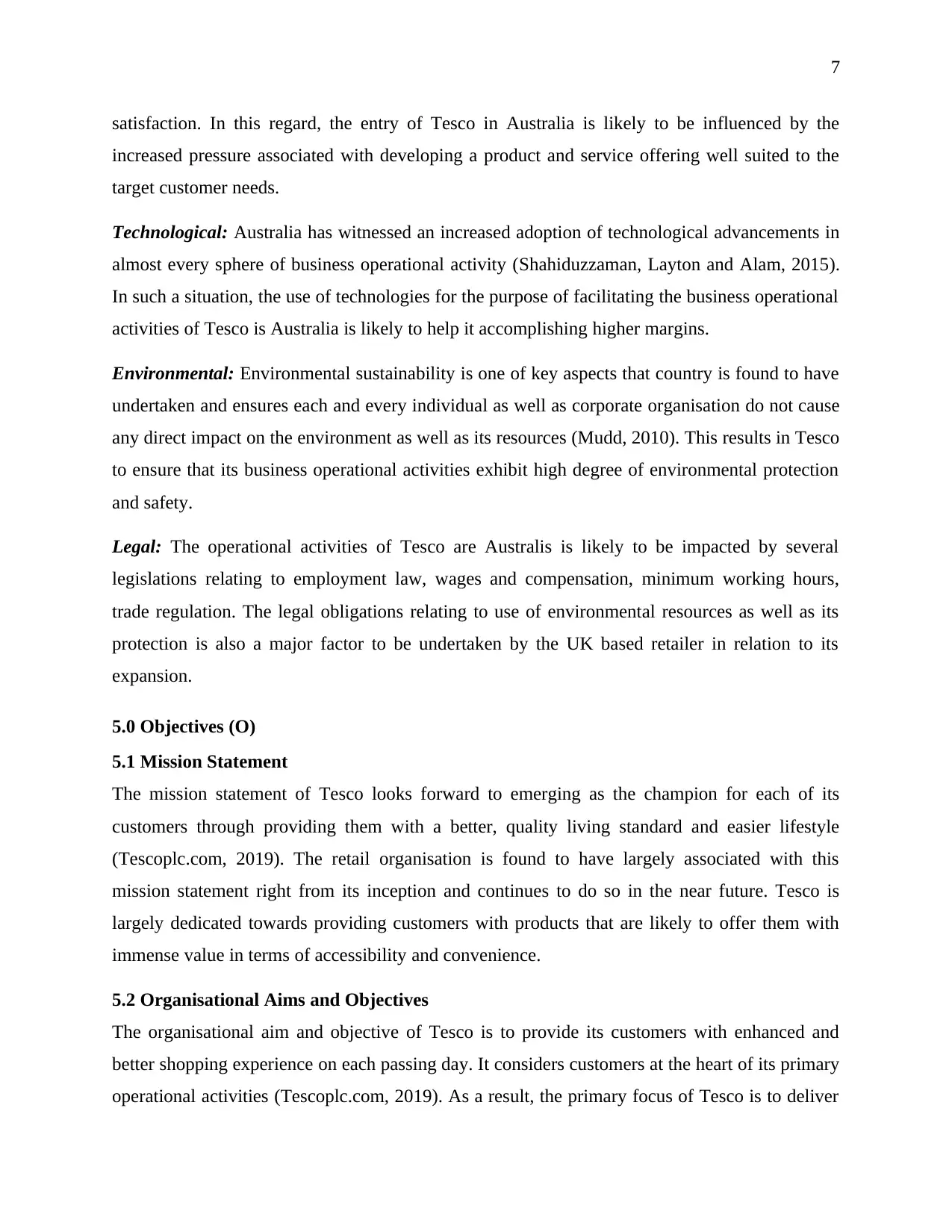
7
satisfaction. In this regard, the entry of Tesco in Australia is likely to be influenced by the
increased pressure associated with developing a product and service offering well suited to the
target customer needs.
Technological: Australia has witnessed an increased adoption of technological advancements in
almost every sphere of business operational activity (Shahiduzzaman, Layton and Alam, 2015).
In such a situation, the use of technologies for the purpose of facilitating the business operational
activities of Tesco is Australia is likely to help it accomplishing higher margins.
Environmental: Environmental sustainability is one of key aspects that country is found to have
undertaken and ensures each and every individual as well as corporate organisation do not cause
any direct impact on the environment as well as its resources (Mudd, 2010). This results in Tesco
to ensure that its business operational activities exhibit high degree of environmental protection
and safety.
Legal: The operational activities of Tesco are Australis is likely to be impacted by several
legislations relating to employment law, wages and compensation, minimum working hours,
trade regulation. The legal obligations relating to use of environmental resources as well as its
protection is also a major factor to be undertaken by the UK based retailer in relation to its
expansion.
5.0 Objectives (O)
5.1 Mission Statement
The mission statement of Tesco looks forward to emerging as the champion for each of its
customers through providing them with a better, quality living standard and easier lifestyle
(Tescoplc.com, 2019). The retail organisation is found to have largely associated with this
mission statement right from its inception and continues to do so in the near future. Tesco is
largely dedicated towards providing customers with products that are likely to offer them with
immense value in terms of accessibility and convenience.
5.2 Organisational Aims and Objectives
The organisational aim and objective of Tesco is to provide its customers with enhanced and
better shopping experience on each passing day. It considers customers at the heart of its primary
operational activities (Tescoplc.com, 2019). As a result, the primary focus of Tesco is to deliver
satisfaction. In this regard, the entry of Tesco in Australia is likely to be influenced by the
increased pressure associated with developing a product and service offering well suited to the
target customer needs.
Technological: Australia has witnessed an increased adoption of technological advancements in
almost every sphere of business operational activity (Shahiduzzaman, Layton and Alam, 2015).
In such a situation, the use of technologies for the purpose of facilitating the business operational
activities of Tesco is Australia is likely to help it accomplishing higher margins.
Environmental: Environmental sustainability is one of key aspects that country is found to have
undertaken and ensures each and every individual as well as corporate organisation do not cause
any direct impact on the environment as well as its resources (Mudd, 2010). This results in Tesco
to ensure that its business operational activities exhibit high degree of environmental protection
and safety.
Legal: The operational activities of Tesco are Australis is likely to be impacted by several
legislations relating to employment law, wages and compensation, minimum working hours,
trade regulation. The legal obligations relating to use of environmental resources as well as its
protection is also a major factor to be undertaken by the UK based retailer in relation to its
expansion.
5.0 Objectives (O)
5.1 Mission Statement
The mission statement of Tesco looks forward to emerging as the champion for each of its
customers through providing them with a better, quality living standard and easier lifestyle
(Tescoplc.com, 2019). The retail organisation is found to have largely associated with this
mission statement right from its inception and continues to do so in the near future. Tesco is
largely dedicated towards providing customers with products that are likely to offer them with
immense value in terms of accessibility and convenience.
5.2 Organisational Aims and Objectives
The organisational aim and objective of Tesco is to provide its customers with enhanced and
better shopping experience on each passing day. It considers customers at the heart of its primary
operational activities (Tescoplc.com, 2019). As a result, the primary focus of Tesco is to deliver
Paraphrase This Document
Need a fresh take? Get an instant paraphrase of this document with our AI Paraphraser

8
excellent and unprecedented customer service every time they attempt to establish direction
communication with the customers. This operational objective of Tesco is critical to helping any
customer irrespective of his or her geographical location. As a result, the expansion of Tesco to
Australia, will largely help the organisation to spread its positive customer experience vibe as
well as viability among the people presently residing in the country.
5.2.1 Think Branding
The branding strategy of Tesco in Australia can largely look forward to signifying in great detail
that it is a customer focussed brand. The primary focus of the branding strategy to be undertaken
by Tesco in Australia is to develop a notable position in the customer minds that the organisation
is largely dedicated in satisfying their retail product needs and demands significntly.
6.0 Strategy (S)
6.1 Porter’s Generic Strategy
Porter’s Generic Strategy is a management tool used for the purpose of accomplishing high
degree of competitive advantage in the selected scope of operations (Tanwar, 2013). Based on
the theoretical model, an organisation can go ahead with accomplishing any three of the
operational strategies, diversification, cost leadership and focus. The cost leadership process
results in organisations to offer minimum prices to customers while differentiation process goes
ahead with offering customers with unique product experience. On the other hand, the focus
aspect of Porter’s Generic Strategy looks forward to making organisations take into
consideration a niche market, followed by developing a product that is well suited to its
customers needs and demands (Nandakumar, Ghobadian and O'Regan, 2011).
6.2 Application of Strategy to Tesco
The most suitable strategy that organisations can take into consideration in relation to developing
high degree of operational activities can be identified in accordance to the Cost leadership factor.
The price effectiveness offered by Tesco in Australia possess immense capability in gaining the
attention of a larger set of target customer.
excellent and unprecedented customer service every time they attempt to establish direction
communication with the customers. This operational objective of Tesco is critical to helping any
customer irrespective of his or her geographical location. As a result, the expansion of Tesco to
Australia, will largely help the organisation to spread its positive customer experience vibe as
well as viability among the people presently residing in the country.
5.2.1 Think Branding
The branding strategy of Tesco in Australia can largely look forward to signifying in great detail
that it is a customer focussed brand. The primary focus of the branding strategy to be undertaken
by Tesco in Australia is to develop a notable position in the customer minds that the organisation
is largely dedicated in satisfying their retail product needs and demands significntly.
6.0 Strategy (S)
6.1 Porter’s Generic Strategy
Porter’s Generic Strategy is a management tool used for the purpose of accomplishing high
degree of competitive advantage in the selected scope of operations (Tanwar, 2013). Based on
the theoretical model, an organisation can go ahead with accomplishing any three of the
operational strategies, diversification, cost leadership and focus. The cost leadership process
results in organisations to offer minimum prices to customers while differentiation process goes
ahead with offering customers with unique product experience. On the other hand, the focus
aspect of Porter’s Generic Strategy looks forward to making organisations take into
consideration a niche market, followed by developing a product that is well suited to its
customers needs and demands (Nandakumar, Ghobadian and O'Regan, 2011).
6.2 Application of Strategy to Tesco
The most suitable strategy that organisations can take into consideration in relation to developing
high degree of operational activities can be identified in accordance to the Cost leadership factor.
The price effectiveness offered by Tesco in Australia possess immense capability in gaining the
attention of a larger set of target customer.

9
7.0 Tactics (T)
7.1 Product
7.1.1 Product Life Cycle
7.0 Tactics (T)
7.1 Product
7.1.1 Product Life Cycle
⊘ This is a preview!⊘
Do you want full access?
Subscribe today to unlock all pages.

Trusted by 1+ million students worldwide
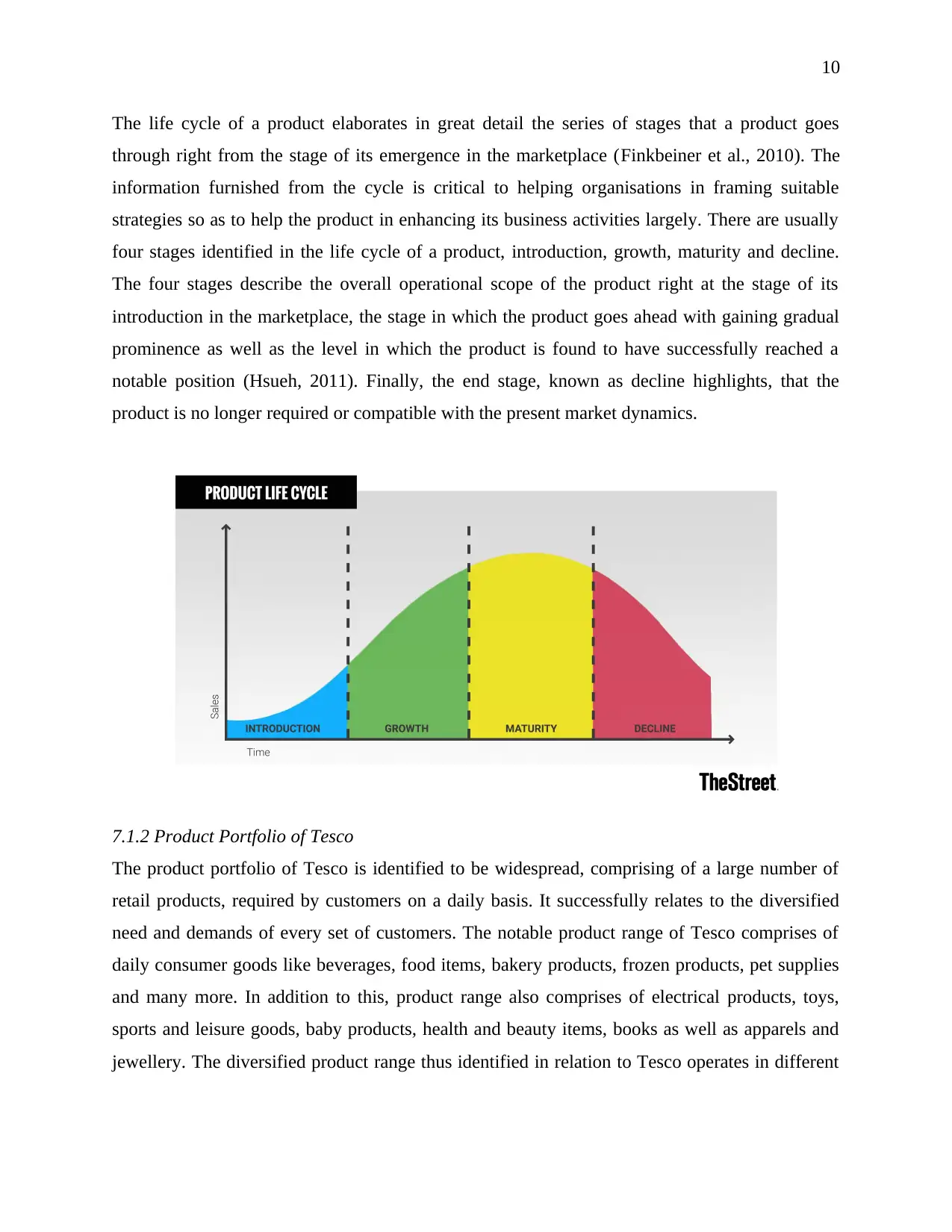
10
The life cycle of a product elaborates in great detail the series of stages that a product goes
through right from the stage of its emergence in the marketplace (Finkbeiner et al., 2010). The
information furnished from the cycle is critical to helping organisations in framing suitable
strategies so as to help the product in enhancing its business activities largely. There are usually
four stages identified in the life cycle of a product, introduction, growth, maturity and decline.
The four stages describe the overall operational scope of the product right at the stage of its
introduction in the marketplace, the stage in which the product goes ahead with gaining gradual
prominence as well as the level in which the product is found to have successfully reached a
notable position (Hsueh, 2011). Finally, the end stage, known as decline highlights, that the
product is no longer required or compatible with the present market dynamics.
7.1.2 Product Portfolio of Tesco
The product portfolio of Tesco is identified to be widespread, comprising of a large number of
retail products, required by customers on a daily basis. It successfully relates to the diversified
need and demands of every set of customers. The notable product range of Tesco comprises of
daily consumer goods like beverages, food items, bakery products, frozen products, pet supplies
and many more. In addition to this, product range also comprises of electrical products, toys,
sports and leisure goods, baby products, health and beauty items, books as well as apparels and
jewellery. The diversified product range thus identified in relation to Tesco operates in different
The life cycle of a product elaborates in great detail the series of stages that a product goes
through right from the stage of its emergence in the marketplace (Finkbeiner et al., 2010). The
information furnished from the cycle is critical to helping organisations in framing suitable
strategies so as to help the product in enhancing its business activities largely. There are usually
four stages identified in the life cycle of a product, introduction, growth, maturity and decline.
The four stages describe the overall operational scope of the product right at the stage of its
introduction in the marketplace, the stage in which the product goes ahead with gaining gradual
prominence as well as the level in which the product is found to have successfully reached a
notable position (Hsueh, 2011). Finally, the end stage, known as decline highlights, that the
product is no longer required or compatible with the present market dynamics.
7.1.2 Product Portfolio of Tesco
The product portfolio of Tesco is identified to be widespread, comprising of a large number of
retail products, required by customers on a daily basis. It successfully relates to the diversified
need and demands of every set of customers. The notable product range of Tesco comprises of
daily consumer goods like beverages, food items, bakery products, frozen products, pet supplies
and many more. In addition to this, product range also comprises of electrical products, toys,
sports and leisure goods, baby products, health and beauty items, books as well as apparels and
jewellery. The diversified product range thus identified in relation to Tesco operates in different
Paraphrase This Document
Need a fresh take? Get an instant paraphrase of this document with our AI Paraphraser
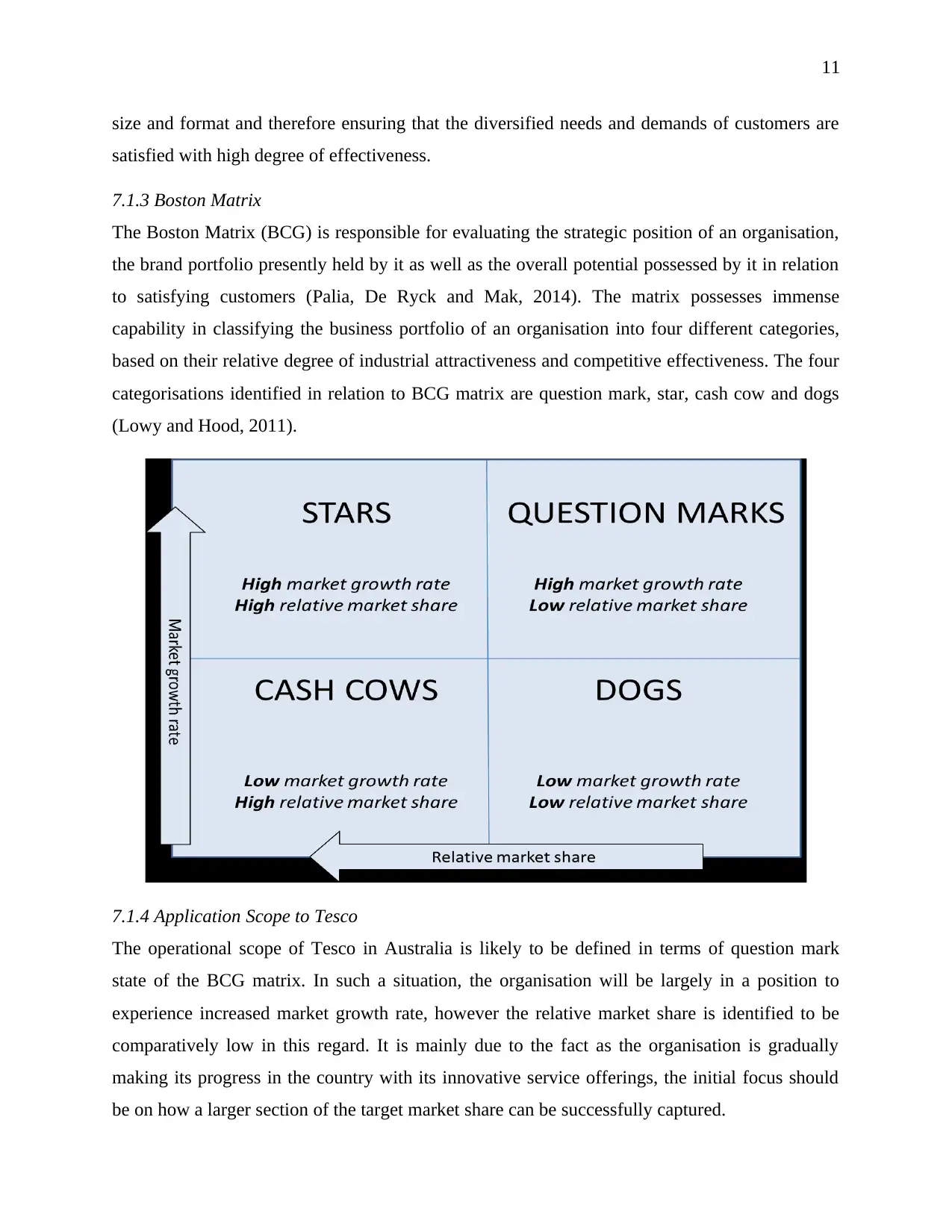
11
size and format and therefore ensuring that the diversified needs and demands of customers are
satisfied with high degree of effectiveness.
7.1.3 Boston Matrix
The Boston Matrix (BCG) is responsible for evaluating the strategic position of an organisation,
the brand portfolio presently held by it as well as the overall potential possessed by it in relation
to satisfying customers (Palia, De Ryck and Mak, 2014). The matrix possesses immense
capability in classifying the business portfolio of an organisation into four different categories,
based on their relative degree of industrial attractiveness and competitive effectiveness. The four
categorisations identified in relation to BCG matrix are question mark, star, cash cow and dogs
(Lowy and Hood, 2011).
7.1.4 Application Scope to Tesco
The operational scope of Tesco in Australia is likely to be defined in terms of question mark
state of the BCG matrix. In such a situation, the organisation will be largely in a position to
experience increased market growth rate, however the relative market share is identified to be
comparatively low in this regard. It is mainly due to the fact as the organisation is gradually
making its progress in the country with its innovative service offerings, the initial focus should
be on how a larger section of the target market share can be successfully captured.
size and format and therefore ensuring that the diversified needs and demands of customers are
satisfied with high degree of effectiveness.
7.1.3 Boston Matrix
The Boston Matrix (BCG) is responsible for evaluating the strategic position of an organisation,
the brand portfolio presently held by it as well as the overall potential possessed by it in relation
to satisfying customers (Palia, De Ryck and Mak, 2014). The matrix possesses immense
capability in classifying the business portfolio of an organisation into four different categories,
based on their relative degree of industrial attractiveness and competitive effectiveness. The four
categorisations identified in relation to BCG matrix are question mark, star, cash cow and dogs
(Lowy and Hood, 2011).
7.1.4 Application Scope to Tesco
The operational scope of Tesco in Australia is likely to be defined in terms of question mark
state of the BCG matrix. In such a situation, the organisation will be largely in a position to
experience increased market growth rate, however the relative market share is identified to be
comparatively low in this regard. It is mainly due to the fact as the organisation is gradually
making its progress in the country with its innovative service offerings, the initial focus should
be on how a larger section of the target market share can be successfully captured.
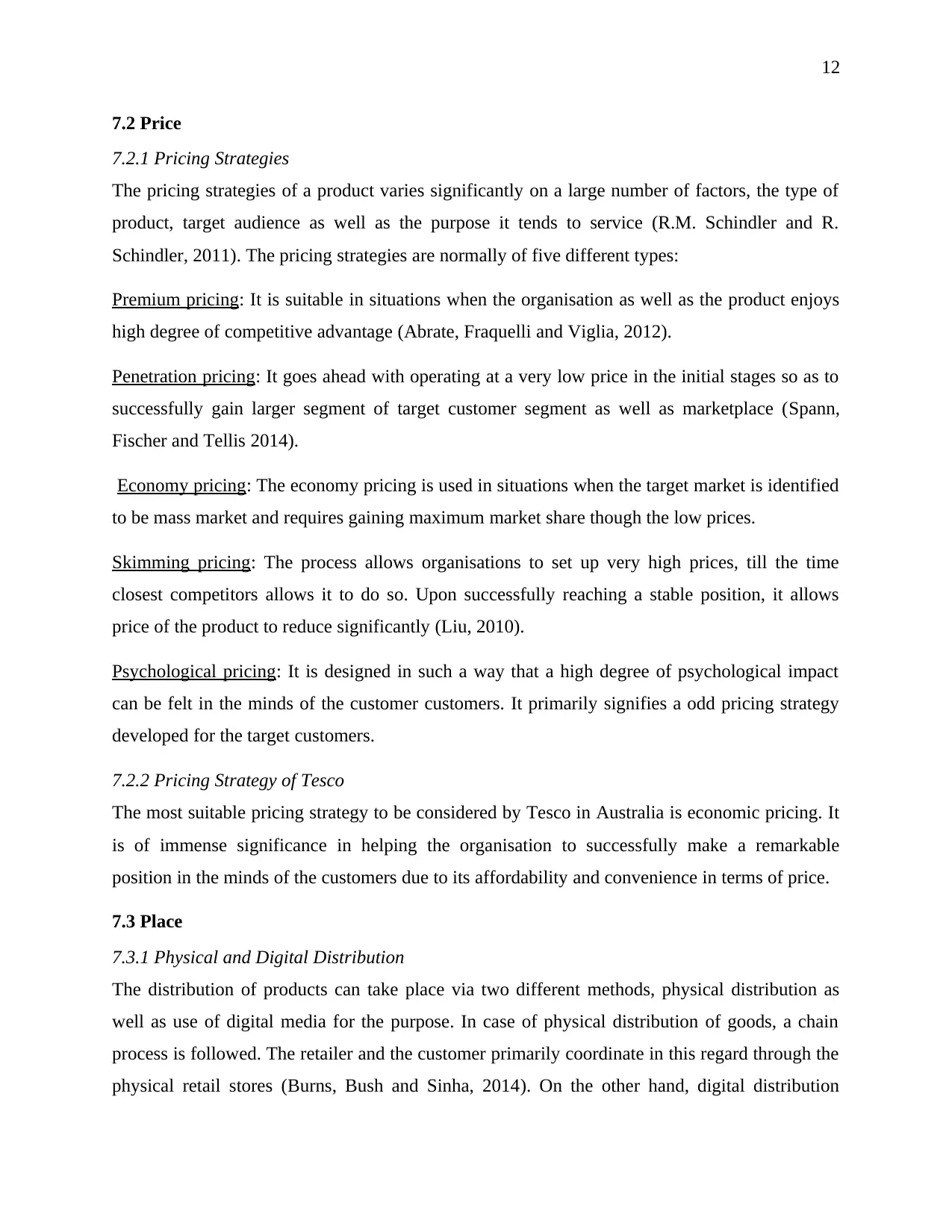
12
7.2 Price
7.2.1 Pricing Strategies
The pricing strategies of a product varies significantly on a large number of factors, the type of
product, target audience as well as the purpose it tends to service (R.M. Schindler and R.
Schindler, 2011). The pricing strategies are normally of five different types:
Premium pricing: It is suitable in situations when the organisation as well as the product enjoys
high degree of competitive advantage (Abrate, Fraquelli and Viglia, 2012).
Penetration pricing: It goes ahead with operating at a very low price in the initial stages so as to
successfully gain larger segment of target customer segment as well as marketplace (Spann,
Fischer and Tellis 2014).
Economy pricing: The economy pricing is used in situations when the target market is identified
to be mass market and requires gaining maximum market share though the low prices.
Skimming pricing: The process allows organisations to set up very high prices, till the time
closest competitors allows it to do so. Upon successfully reaching a stable position, it allows
price of the product to reduce significantly (Liu, 2010).
Psychological pricing: It is designed in such a way that a high degree of psychological impact
can be felt in the minds of the customer customers. It primarily signifies a odd pricing strategy
developed for the target customers.
7.2.2 Pricing Strategy of Tesco
The most suitable pricing strategy to be considered by Tesco in Australia is economic pricing. It
is of immense significance in helping the organisation to successfully make a remarkable
position in the minds of the customers due to its affordability and convenience in terms of price.
7.3 Place
7.3.1 Physical and Digital Distribution
The distribution of products can take place via two different methods, physical distribution as
well as use of digital media for the purpose. In case of physical distribution of goods, a chain
process is followed. The retailer and the customer primarily coordinate in this regard through the
physical retail stores (Burns, Bush and Sinha, 2014). On the other hand, digital distribution
7.2 Price
7.2.1 Pricing Strategies
The pricing strategies of a product varies significantly on a large number of factors, the type of
product, target audience as well as the purpose it tends to service (R.M. Schindler and R.
Schindler, 2011). The pricing strategies are normally of five different types:
Premium pricing: It is suitable in situations when the organisation as well as the product enjoys
high degree of competitive advantage (Abrate, Fraquelli and Viglia, 2012).
Penetration pricing: It goes ahead with operating at a very low price in the initial stages so as to
successfully gain larger segment of target customer segment as well as marketplace (Spann,
Fischer and Tellis 2014).
Economy pricing: The economy pricing is used in situations when the target market is identified
to be mass market and requires gaining maximum market share though the low prices.
Skimming pricing: The process allows organisations to set up very high prices, till the time
closest competitors allows it to do so. Upon successfully reaching a stable position, it allows
price of the product to reduce significantly (Liu, 2010).
Psychological pricing: It is designed in such a way that a high degree of psychological impact
can be felt in the minds of the customer customers. It primarily signifies a odd pricing strategy
developed for the target customers.
7.2.2 Pricing Strategy of Tesco
The most suitable pricing strategy to be considered by Tesco in Australia is economic pricing. It
is of immense significance in helping the organisation to successfully make a remarkable
position in the minds of the customers due to its affordability and convenience in terms of price.
7.3 Place
7.3.1 Physical and Digital Distribution
The distribution of products can take place via two different methods, physical distribution as
well as use of digital media for the purpose. In case of physical distribution of goods, a chain
process is followed. The retailer and the customer primarily coordinate in this regard through the
physical retail stores (Burns, Bush and Sinha, 2014). On the other hand, digital distribution
⊘ This is a preview!⊘
Do you want full access?
Subscribe today to unlock all pages.

Trusted by 1+ million students worldwide
1 out of 17
Related Documents
Your All-in-One AI-Powered Toolkit for Academic Success.
+13062052269
info@desklib.com
Available 24*7 on WhatsApp / Email
![[object Object]](/_next/static/media/star-bottom.7253800d.svg)
Unlock your academic potential
Copyright © 2020–2025 A2Z Services. All Rights Reserved. Developed and managed by ZUCOL.





